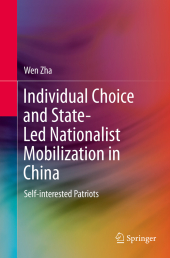 Neuerscheinungen 2016Stand: 2020-02-01 |
Schnellsuche
ISBN/Stichwort/Autor
|
Herderstraße 10
10625 Berlin
Tel.: 030 315 714 16
Fax 030 315 714 14
info@buchspektrum.de |

Wen Zha
Individual Choice and State-Led Nationalist Mobilization in China
Self-interested Patriots
Softcover reprint of the original 1st ed. 2015. 2016. xvi, 158 S. 1 SW-Abb. 235 mm
Verlag/Jahr: SPRINGER, BERLIN; SPRINGER BERLIN HEIDELBERG 2016
ISBN: 3-662-52629-8 (3662526298)
Neue ISBN: 978-3-662-52629-3 (9783662526293)
Preis und Lieferzeit: Bitte klicken
This book presents a comparative historical analysis of state-led nationalist movements in Chinese history, which counters current claims that popular nationalism in present-day China is strong enough to sustain costly expansionist wars. Popular nationalism in China has been on the rise since the early 1990s to the concern of many observers. Some have even asked whether China will become another Germany. A comparative historical analysis of pre-war and wartime nationalist mobilization helps us better understand how individuals formulate their opinions under extreme conditions. It concludes that the public´s weak perception of foreign threats, taken together with pro-minority domestic institutions, may significantly undermine the state´s efforts at nationalist mobilization and thus limit its capability to pursue external expansion or other strategic goals.
Chapter 1 Introduction.- Chapter 2 Explaining State-Led Nationalist Movements: Individual Choice and State Mobilization.- Chapter 3 The New Life Movement in Jiangxi: Weak Threat Perceptions, Pro-Minority Institutions, and the Limits of Nationalism.- Chapter 4 Sichuan during the Sino-Japanese War: Strong Threat Perceptions, Pro-Minority Institutions, and Limited Success of Nationalist Mobilization.- Chapter 5 The Lower Yangtze Region during the Korean War: Strong Threat Perceptions, Pro-Majority Institutions, and Successful Nationalist Mobilization.- Chapter 6 The Great Leap Forward in Sichuan: Weak Threat Perceptions, Hybrid Institutions, and the Mixed Outcomes of Mobilization.- Chapter 7 Conclusion.


